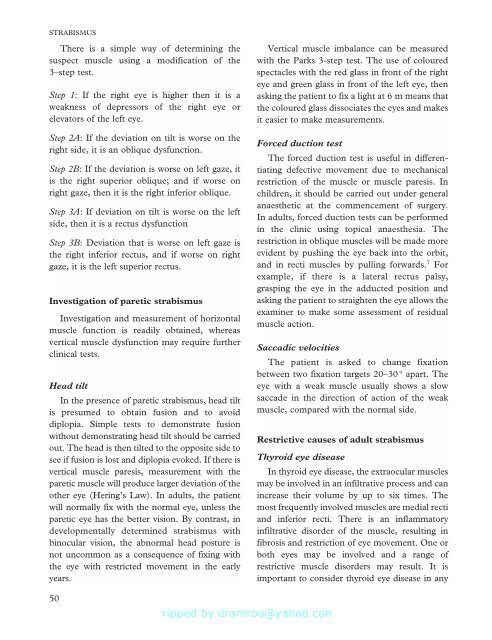Strabismus - Fundamentals of Clinical Ophthalmology.pdf
Strabismus - Fundamentals of Clinical Ophthalmology.pdf
Strabismus - Fundamentals of Clinical Ophthalmology.pdf
Create successful ePaper yourself
Turn your PDF publications into a flip-book with our unique Google optimized e-Paper software.
STRABISMUS<br />
There is a simple way <strong>of</strong> determining the<br />
suspect muscle using a modification <strong>of</strong> the<br />
3–step test.<br />
Step 1: If the right eye is higher then it is a<br />
weakness <strong>of</strong> depressors <strong>of</strong> the right eye or<br />
elevators <strong>of</strong> the left eye.<br />
Step 2A: If the deviation on tilt is worse on the<br />
right side, it is an oblique dysfunction.<br />
Step 2B: If the deviation is worse on left gaze, it<br />
is the right superior oblique; and if worse on<br />
right gaze, then it is the right inferior oblique.<br />
Step 3A: If deviation on tilt is worse on the left<br />
side, then it is a rectus dysfunction<br />
Step 3B: Deviation that is worse on left gaze is<br />
the right inferior rectus, and if worse on right<br />
gaze, it is the left superior rectus.<br />
Investigation <strong>of</strong> paretic strabismus<br />
Investigation and measurement <strong>of</strong> horizontal<br />
muscle function is readily obtained, whereas<br />
vertical muscle dysfunction may require further<br />
clinical tests.<br />
Head tilt<br />
In the presence <strong>of</strong> paretic strabismus, head tilt<br />
is presumed to obtain fusion and to avoid<br />
diplopia. Simple tests to demonstrate fusion<br />
without demonstrating head tilt should be carried<br />
out. The head is then tilted to the opposite side to<br />
see if fusion is lost and diplopia evoked. If there is<br />
vertical muscle paresis, measurement with the<br />
paretic muscle will produce larger deviation <strong>of</strong> the<br />
other eye (Hering’s Law). In adults, the patient<br />
will normally fix with the normal eye, unless the<br />
paretic eye has the better vision. By contrast, in<br />
developmentally determined strabismus with<br />
binocular vision, the abnormal head posture is<br />
not uncommon as a consequence <strong>of</strong> fixing with<br />
the eye with restricted movement in the early<br />
years.<br />
Vertical muscle imbalance can be measured<br />
with the Parks 3-step test. The use <strong>of</strong> coloured<br />
spectacles with the red glass in front <strong>of</strong> the right<br />
eye and green glass in front <strong>of</strong> the left eye, then<br />
asking the patient to fix a light at 6 m means that<br />
the coloured glass dissociates the eyes and makes<br />
it easier to make measurements.<br />
Forced duction test<br />
The forced duction test is useful in differentiating<br />
defective movement due to mechanical<br />
restriction <strong>of</strong> the muscle or muscle paresis. In<br />
children, it should be carried out under general<br />
anaesthetic at the commencement <strong>of</strong> surgery.<br />
In adults, forced duction tests can be performed<br />
in the clinic using topical anaesthesia. The<br />
restriction in oblique muscles will be made more<br />
evident by pushing the eye back into the orbit,<br />
and in recti muscles by pulling forwards. 7 For<br />
example, if there is a lateral rectus palsy,<br />
grasping the eye in the adducted position and<br />
asking the patient to straighten the eye allows the<br />
examiner to make some assessment <strong>of</strong> residual<br />
muscle action.<br />
Saccadic velocities<br />
The patient is asked to change fixation<br />
between two fixation targets 20–30 º apart. The<br />
eye with a weak muscle usually shows a slow<br />
saccade in the direction <strong>of</strong> action <strong>of</strong> the weak<br />
muscle, compared with the normal side.<br />
Restrictive causes <strong>of</strong> adult strabismus<br />
Thyroid eye disease<br />
In thyroid eye disease, the extraocular muscles<br />
may be involved in an infiltrative process and can<br />
increase their volume by up to six times. The<br />
most frequently involved muscles are medial recti<br />
and inferior recti. There is an inflammatory<br />
infiltrative disorder <strong>of</strong> the muscle, resulting in<br />
fibrosis and restriction <strong>of</strong> eye movement. One or<br />
both eyes may be involved and a range <strong>of</strong><br />
restrictive muscle disorders may result. It is<br />
important to consider thyroid eye disease in any<br />
50










![SISTEM SENSORY [Compatibility Mode].pdf](https://img.yumpu.com/20667975/1/190x245/sistem-sensory-compatibility-modepdf.jpg?quality=85)





